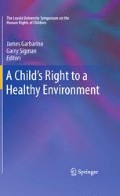Abstract
Some kids are smarter than others. Some are better looking than others. Some are kinder and more sensitive than others. Some are more talented than others. Some are more confident than others. But all these differences pale in comparison with what kids share and kids do not change much at their core over the years. They want to be valued and accepted. They want to be safe. They want to learn and explore. They want to play and have fun. They need to find meaning in their lives and make a spiritual connection (Garbarino, 1995).
Access this chapter
Tax calculation will be finalised at checkout
Purchases are for personal use only
References
American Psychiatric Association. (2000). APA position statement on psychiatric treatment and sexual orientation, December 11, 1998. Retrieved from http://www.psych.org/psych_pract/copptherapyaddendum83100.cfm
Boyce, M. (2001). Zoroastrians: Their religious beliefs and practices. London: Routledge.
Bedard, C. (2007). Children’s rights are human rights. Chicago: Loyola University Press, Center for the Human Rights of Children.
Briscoe, D. (2007). Katrina: A systematic failure. Retrieved on September 07, 2007 from http://www.msnbc.msn.com/id/20546339/site/newsweek/
Brokaw, T. (1998). The greatest generation. New York: Random House.
Eron, L. D., Gentry, J. H., & Schlegel, P. (1994). Reason to hope. A psychosocial perspective on violence & youth. Washington, DC: American Psychological Association.
Garbarino, J. (1995). Raising children in a socially toxic environment. San Francisco: Jossey-Bass.
Garbarino, J. (1999) Lost Boys: Why Our Sons Turn Violent and How We Can Save Them. NY: Free Press.
Garbarino, J. (2002). Foreword: Pathways from childhood trauma to adolescent violence and delinquency. Journal of Aggression, Maltreatment & Trauma, 6(1), 22–29.
Garbarino, J. (2008). Children and the dark side of human experience: Confronting global realities and rethinking child development. NY: Springer
Garbarino, J., Kostelny, K., & Dubrow, N. (1991). No place to be a child: Growing up in a war zone. New York: Lexington Books.
Garofalo, R., Wolf, C., Kessel, J., Palfrey, J., & Durant, R. H. (1998). The association between health risk behaviors and sexual orientation among a school based sample of adolescents. Pediatrics, 101(5), 895–902.
Hilmes, M. (2004). The television history book. London: British Film Institute.
Kaplan, S. J., Pelcovitz, D., & Fornari, V. (2005). The treatment of children impacted by the World Trade Center attack. New York: Hawthorn.
Kelly, J. A., & Amirkhanian, Y. A. (2003). The newest epidemic: A review of HIV/AIDS in central and eastern Europe. International Journal of STD & AIDS, 14(6), 361–371.
Lickona, T. (2004). Character matters: How to help our children develop good judgment, integrity, and other essential virtues. New York: Touchstone.
Loeber, R., & Farrington, D. (1999). Serious and violent juvenile offenders: Risk factors and successful interventions. Thousand Oaks, CA: Sage.
Luke, C. (1990). Constructing the child viewer: A history of the American discourse on television and children, 1950–1980. New York: Praeger.
Mulhall, B. P. (1996). Sex and travel: studies of sexual behaviour, disease and health promotion in international travellers – a global review. International Journal of STD & AIDS, 7(7), 455–465.
Shales, A. (2007). The forgotten man: A new history of the great depression. New York: HarperCollins.
Updike, J. (2007). Laissez-faire is more: A revisionist history of the depression. The New Yorker, July 02.
Wadlow, R. (2002). Violence in Columbia, 1990–2000: Waging war and negotiating peace. St. Paul, MN: Professors World Peace Academy.
Author information
Authors and Affiliations
Corresponding author
Editor information
Editors and Affiliations
Rights and permissions
Copyright information
© 2010 Springer Science+Business Media, LLC
About this chapter
Cite this chapter
Garbarino, J. (2010). The Right to a Healthy Social Environment: Protecting Children from Social Toxicity. In: Garbarino, J., Sigman, G. (eds) A Child's Right to a Healthy Environment. The Loyola University Symposium on the Human Rights of Children, vol 1. Springer, New York, NY. https://doi.org/10.1007/978-1-4419-6791-6_13
Download citation
DOI: https://doi.org/10.1007/978-1-4419-6791-6_13
Published:
Publisher Name: Springer, New York, NY
Print ISBN: 978-1-4419-6789-3
Online ISBN: 978-1-4419-6791-6
eBook Packages: MedicineMedicine (R0)

